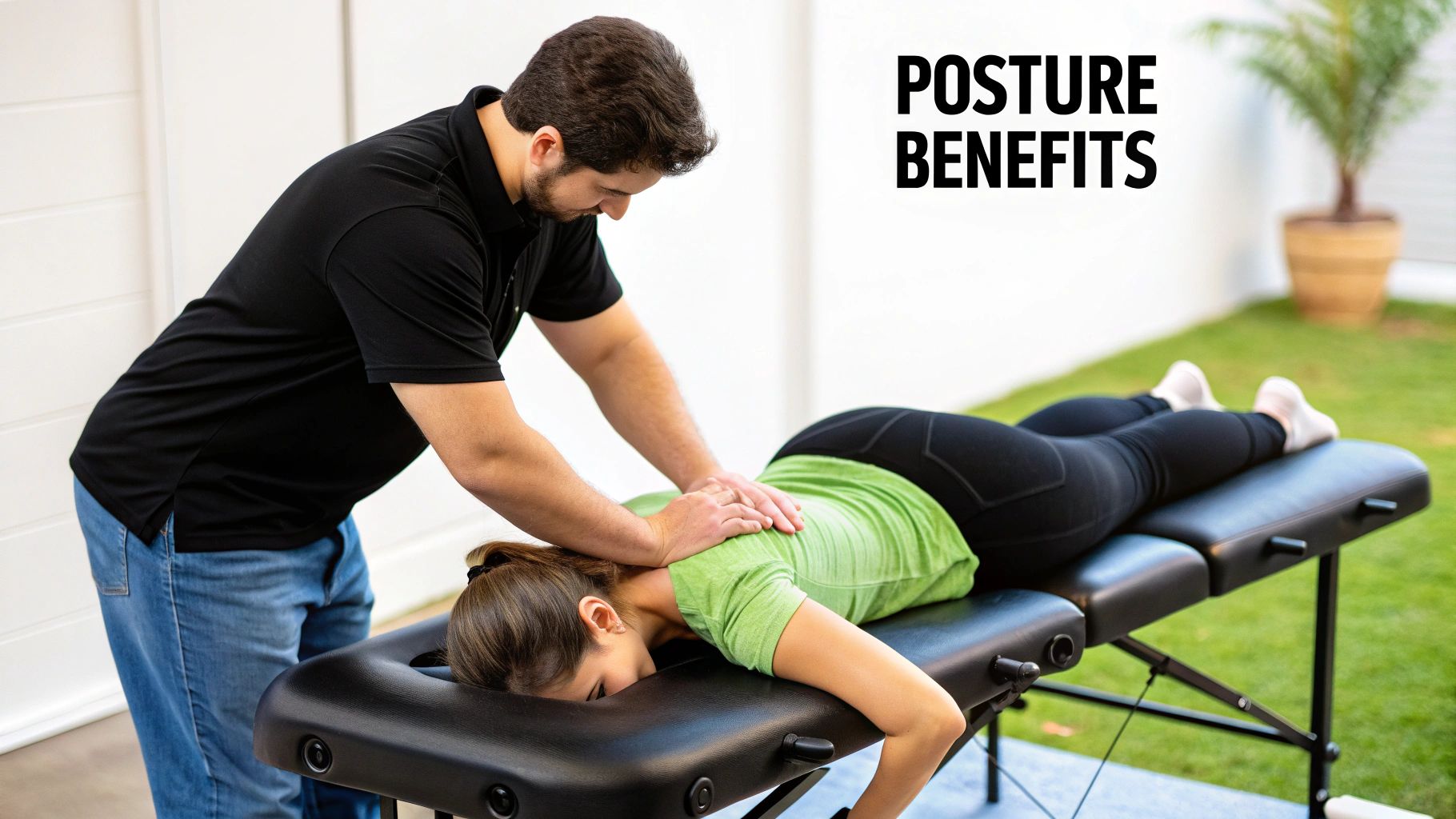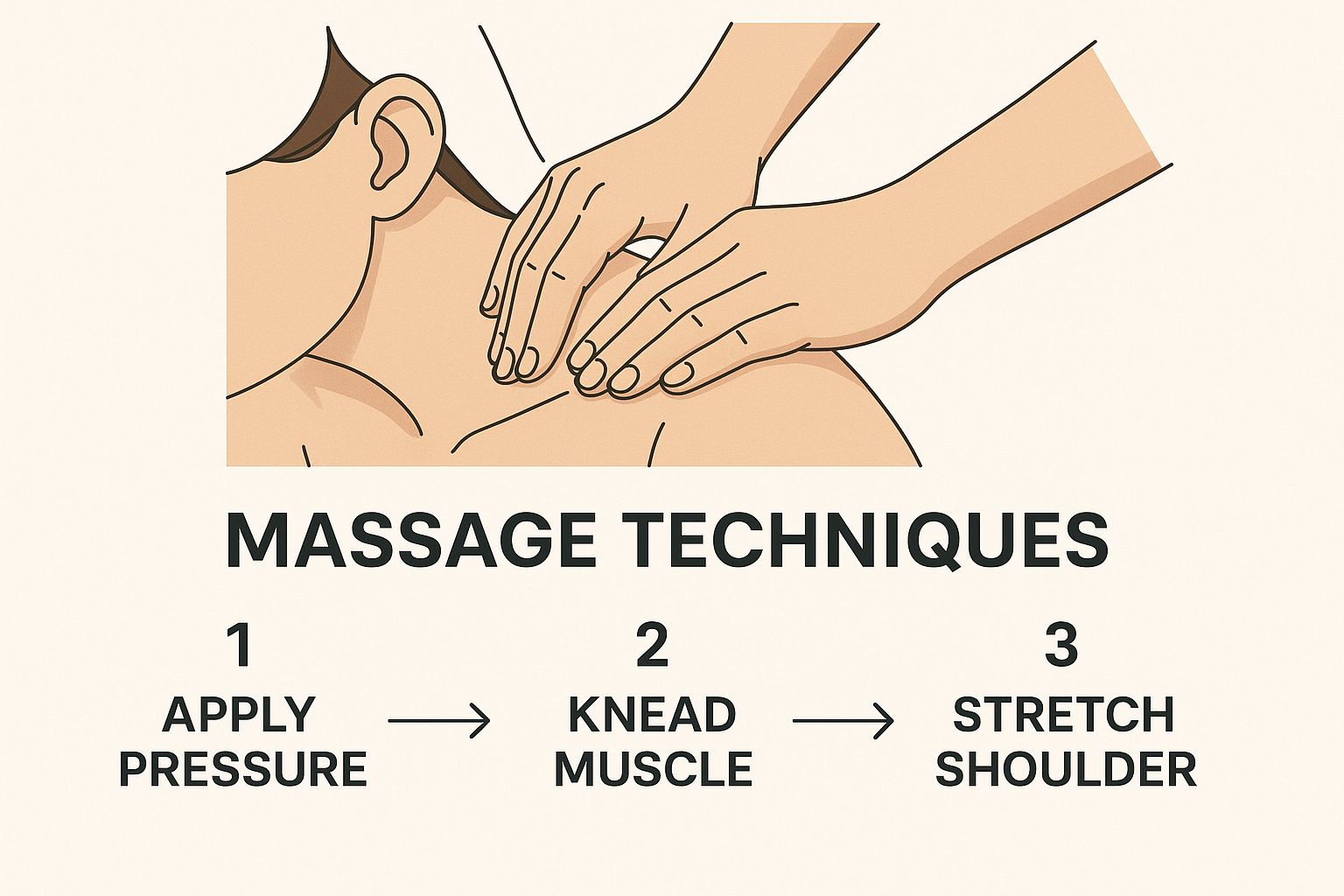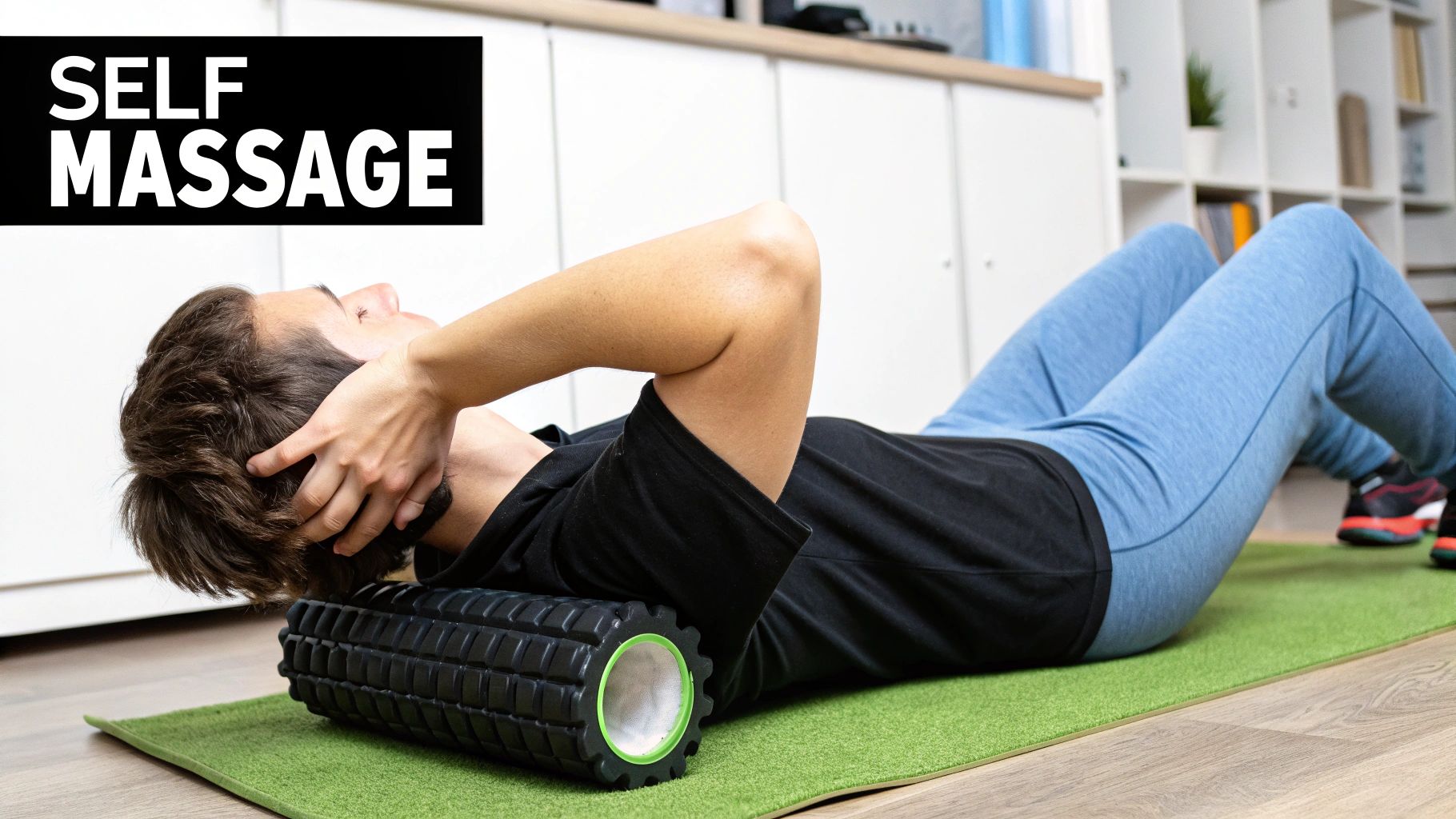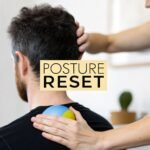We all know the feeling. Long hours hunched over a keyboard, endless scrolling on a phone, and that nagging ache that just won't quit. This isn't just "bad slouching." It's a physical response to modern life, creating deep-seated muscle imbalances that pull your body out of alignment. The good news is that targeted massage for posture can directly address these root causes, offering more than just temporary relief.
How Modern Life Wrecks Your Posture
Think about your body's position throughout the day. Chances are, you spend a significant amount of time with your head pushed forward, shoulders rounded, and lower back in a slumped C-shape. Over weeks, months, and years, your body starts to treat this as its new normal.
This forces some muscles into a state of chronic tightness, while their opposing muscles become weak and stretched out. This tug-of-war is what we call a muscular imbalance, and it literally pulls your skeleton out of its natural alignment. The result is a cascade of issues: persistent neck pain, tension headaches, lower back strain, and even compromised breathing.
Key Insight: Good posture isn’t about consciously trying to sit up straight all day. It's about restoring balance to your muscles so that proper alignment becomes your body's effortless, default state.
This isn’t a minor inconvenience; it’s a massive health issue. A staggering 80% of people will experience back pain at some point, and posture is a huge contributing factor. In fact, studies show nearly 70% of office workers suffer from neck pain directly linked to their posture. If you want to dive deeper, you can explore how modern work affects your body and how massage therapy can be part of the solution.
Uncovering The Real Culprits
To fix the problem, you have to know what's actually causing it. Every common postural problem, from "tech neck" to a tilted pelvis, has a specific group of tight muscles pulling you out of whack. A skilled massage therapist knows exactly which ones to target.
For instance, rounded shoulders aren't just a sign of a weak back. More often, the primary cause is incredibly tight chest muscles (the pectorals) that are physically pulling your shoulders forward and inward. Likewise, a forward head position isn't just about your neck. It’s driven by overworked muscles at the base of your skull (the suboccipitals) and chronically tight upper traps.
Effective massage for posture goes beyond simply rubbing the sore spot. It’s about strategically releasing these tight "guy wires" to allow your entire structure to return to a more balanced and comfortable position.
Common Postural Issues and Targeted Massage Solutions
This table breaks down some of the most common postural deviations we see today and highlights the key muscle groups a massage therapist can work on to bring you back into balance.
| Postural Problem | Affected Muscle Groups | How Massage Helps |
|---|---|---|
| Forward Head ("Tech Neck") | Neck extensors, suboccipitals, upper trapezius | Releases chronic tension at the base of the skull and across the shoulders, allowing the head to retract to a neutral position. |
| Rounded Shoulders | Pectoral muscles (chest), anterior deltoids | Lengthens the tight muscles in the front of the body that pull the shoulders forward, promoting a more open chest. |
| Anterior Pelvic Tilt | Hip flexors, quadriceps, erector spinae (low back) | Loosens the tight hip flexors and lower back muscles that pull the pelvis forward, restoring a neutral pelvic alignment. |
By understanding these connections, you can see how targeted massage therapy is a powerful tool for dismantling years of postural strain, one tight muscle at a time.
Finding Your Body's Unique Postural Pattern

Before you can really make a dent in your posture with massage, you first have to play detective. Think of your body as a finely tuned structure. When everything is in balance, you stand tall with ease. But over time, some muscles get tight and short while others become long and weak, pulling your entire frame out of whack.
This is what we mean by muscular imbalances. It's more than just "slouching." It's a physical tug-of-war where tight muscles, like your chest and hip flexors, are overpowering their weaker partners, like your upper back muscles and glutes. Your daily grind—whether it's at a desk or on your feet—creates a very specific postural signature unique to you.
The Mirror Test: A Quick Self-Check
Your first step is to get an honest look at what's going on. Go stand in front of a full-length mirror and just relax into your usual stance. Don't try to "fix" anything or stand up straight. We want to see your body's default setting.
Now, let's look for a few common giveaways:
- Head Position: Does your head seem to jut forward instead of resting right over your shoulders? If your ears are out in front of your shoulder line, you’re likely dealing with forward head posture. This is often caused by chronically tight muscles at the base of your skull and front of your neck.
- Shoulder Alignment: Are your shoulders slumped and rolling inward? A dead giveaway is if the backs of your hands face forward when your arms are relaxed at your sides. This is classic rounded shoulders, usually because tight chest muscles are pulling everything forward.
- Pelvic Tilt: Put your hands on your hips, like you're striking a pose. Does your pelvis feel like it's tipping forward, creating a deep arch in your lower back? That's an anterior pelvic tilt, a super common imbalance, especially if you sit a lot, which shortens the hip flexors.
Here's a quick reality check I give my clients: the wall test. Stand with your back flat against a wall. Your heels, butt, and shoulder blades should all be touching it. Now, check the back of your head. How much space is there between it and the wall? If it’s more than a two-inch gap, that's a pretty clear sign of forward head posture.
Tuning Into What Your Body Is Telling You
Visuals are great, but you can also feel these imbalances pretty clearly.
For example, someone with seriously rounded shoulders might find it almost impossible to lie flat on the floor without their shoulders popping up. That isn't just a lack of flexibility; it's a direct signal that the pectoral muscles are shortened and need targeted massage work to release them.
It's the same story with that nagging, knotty ache in your upper shoulders and neck. That's a huge clue that those muscles are working overtime, trying desperately to hold up a head that has drifted too far forward. These physical sensations aren't random aches—they're your body's way of highlighting the exact source of the problem.
By putting these visual checks and physical feelings together, you start to build a clear map of your body's unique imbalances. This personal blueprint is what makes all the difference. It helps you move from a generic, feel-good massage to a strategic massage for posture that goes right after the muscles causing the trouble, giving your body a real chance to find its way back to effortless alignment.
Real Massage Techniques That Correct Posture
Alright, let's get hands-on. This is where the real change happens. We're moving beyond general advice and getting into specific massage routines you can do yourself to start seeing and feeling a difference in your posture. Think of this as your personal toolkit for tackling the common problem areas that pull your body out of alignment.
We’ll be zeroing in on those chronically tight muscles—the ones that are almost always the true culprits behind rounded shoulders and that nagging "tech neck." For each technique, I'll walk you through the pressure, timing, and exactly what you should be feeling, so you can start making progress right away.
This infographic gives you a great visual breakdown of which massage techniques hit which postural problems.

As you can see, it’s all about combining targeted pressure with specific movements to really let that postural tension go.
Releasing Rounded Shoulders
Most people think rounded shoulders come from a weak back, but that’s rarely the whole story. The primary driver is almost always tight pectoral (chest) muscles pulling your shoulders forward and in. To fight back, all you need is a massage ball.
- Tool: A lacrosse ball is perfect. A firm tennis ball works too.
- Technique: Find a wall and stand facing it. Tuck the ball into your upper chest, right below the collarbone and just off to the side of your sternum. Now, lean into the wall to apply some pressure.
- Movement: Start slowly rolling the ball across your pec muscles with small, deliberate movements. When you hit a spot that feels tender or "knotty," stop. Just hold that pressure for 20-30 seconds and breathe deeply into it. To take it a step further, you can slowly raise and lower the arm on that same side to deepen the release.
What you're doing here is directly lengthening those tight muscle fibers that are literally pulling you forward. This allows your shoulders to finally relax back into a more natural, open position. It’s a trick many athletes use to stay mobile, which you can read more about in our article on deep tissue massage for athletes.
Alleviating Forward Head Posture
That all-too-common "tech neck" is the result of overworked muscles at the base of your skull and in your upper back. They're in a constant battle with gravity, trying to hold up a head that's drifted too far forward from looking at screens.
Expert Tip: Don't just work on the back of your neck! A lot of the tension comes from the front. The sternocleidomastoid (SCM) muscles, those ropey ones on the front and sides of your neck, get incredibly tight. Gently pinching and rolling these muscles between your thumb and forefinger can bring a surprising amount of relief.
For the back of your neck and shoulders, your own hands are the perfect tool. Sit comfortably, and with your opposite hand, use your fingertips to apply firm, kneading pressure to that meaty upper trapezius muscle between your neck and shoulder. Slowly work your way up toward the base of your skull, paying extra attention to any sore spots you find.
And this isn't just theory. Studies have confirmed that this kind of targeted massage for posture makes a real difference. One study on office workers found that regular massage led to significant improvements in their neck and shoulder posture, not to mention a big drop in the pain that comes from sitting at a desk all day. You can dig into similar findings about the benefits of posture-correcting massage.
Unlocking the Upper Back
Your thoracic spine—that's your upper and mid-back—can get incredibly stiff and stuck, which is a major contributor to a slouched posture. Your best friend for this job is a foam roller.
Start by lying on the floor with the foam roller positioned horizontally under your shoulder blades. Plant your feet flat on the floor with your knees bent.
Gently cradle your head with your hands (don’t pull on your neck!) and lift your hips just a bit off the floor.
Now, use your legs to slowly roll your body back and forth, moving the roller from the bottom of your neck down to about the middle of your back. This movement helps get the individual vertebrae moving while releasing the tight muscles around your spine. Give it about one to two minutes, focusing on slow, deep breaths to encourage your muscles to relax.
Knowing When It’s Time to See a Professional

As great as at-home techniques are for day-to-day relief, there comes a point where you need to call in a professional. Self-massage can only take you so far. If you're wrestling with chronic pain, a serious postural deviation like a pronounced pelvic tilt, or you’ve simply hit a wall with your own efforts, it’s time.
A licensed therapist brings a trained eye to the table—literally. They can spot imbalance patterns you’d never notice and get to muscles that are impossible for you to reach on your own. Think of it like this: your daily self-care is like brushing your teeth, while a professional session is the deep cleaning you get from a dental hygienist. Both are crucial, but one provides the powerful reset your body needs to truly change.
Finding the Right Type of Bodywork
When it comes to fixing posture, not just any massage will do. A relaxing Swedish massage is wonderful, but for releasing the deep-seated patterns holding you out of alignment, you need something more targeted.
Here are the heavy hitters I recommend to my own clients:
- Deep Tissue Massage: This is the gold standard for postural work. Using firm, slow strokes, a therapist can break down the chronic adhesions—those stubborn, ropey bands of muscle—that are common in the chest, upper back, and hips.
- Myofascial Release: This technique is all about the fascia, the web of connective tissue that wraps around everything in your body. Gentle, sustained pressure helps "unstick" fascial restrictions, which can dramatically improve your range of motion and release long-held tension.
- Trigger Point Therapy: Got a specific "knot" that shoots pain somewhere else when you press it? That's a trigger point. This therapy applies direct, focused pressure to deactivate these points, which can bring instant relief and restore proper muscle function.
My Experience: The best therapists rarely stick to just one modality. They'll often blend these approaches, using deep tissue for broad areas, myofascial work for that "stuck" feeling, and trigger point therapy to zap specific knots. This is what makes a session a true massage for posture rather than just a generic rubdown.
How to Talk to Your Therapist for the Best Results
Clear communication is everything. Walking in and just saying "my back hurts" isn't enough. You need to give them a roadmap.
Try being more specific: "I feel this constant pulling in my right shoulder after a day at my desk," or "My low back feels like it's always arched, and the front of my hips are incredibly tight." This kind of detail helps them zero in on the root cause.
It's an interesting side note that therapists themselves are highly susceptible to postural strain. One study found that many therapists work in a forward-flexed position, which puts a huge load on their own back and neck muscles. You can read more about the ergonomic risks in massage therapy, and it gives you some insight into why they're so good at spotting these issues in others.
For real, lasting postural changes, you'll likely need a series of sessions. I usually suggest clients start with weekly appointments for the first month to build momentum. After that, you can often scale back to bi-weekly or monthly visits for maintenance as your body starts to hold its new, healthier alignment.
Making Good Posture Your New Normal
Massage therapy is brilliant at doing the heavy lifting—releasing those deep-seated muscle restrictions that have been pulling you out of alignment for years. But what happens after you leave the massage table and step back into your daily life? Real, lasting change isn't just about the release. It's about building new habits that support your posture for the long haul.
Think of it like this: your massage session is a reset button, bringing your body back to a more neutral, balanced state. From there, your job is to create an environment and lifestyle that helps it stay there. This is how you shift good posture from a conscious, constant effort into your body's new, unconscious default setting.
It all comes down to weaving posture-friendly practices into your everyday routine so seamlessly that they become second nature. Doing so is the key to preventing those old patterns of tension and imbalance from creeping back in.
Creating a Posture-Friendly Environment
It's easy to underestimate just how much our surroundings impact our bodies. A few simple, strategic tweaks to your daily environment can make a world of difference, especially at your workstation, where most of us spend a huge chunk of our day.
- Elevate Your Screen: Position your monitor so the top third of the screen is right at eye level. This one change is incredibly effective at preventing the forward head drift that causes "tech neck."
- Support Your Lower Back: If your chair’s lumbar support is lacking, you don't need to buy a whole new chair. A small, rolled-up towel or a dedicated lumbar pillow can do wonders to maintain the natural curve of your lower spine and stop you from slouching.
- Keep Your Feet Flat: Your feet should be able to rest flat on the floor, with your knees bent at roughly a 90-degree angle. If they don't quite reach, a small footrest is a great investment. This grounds your posture and keeps your pelvis stable.
These small ergonomic adjustments aren't just for comfort—they actively prevent the very muscle imbalances that a massage for posture works so hard to correct. For those who find sitting is a major source of discomfort, our guide on using massage therapy for back pain offers even more targeted strategies.
Key Takeaway: Your environment should support your posture, not fight against it. A few intentional changes to your chair, desk, and screen setup can passively reinforce the work done during your massage, making good alignment feel almost effortless.
Integrating Mindful Movement
Lasting postural change also demands that you break up long periods of being still. Your body was designed for movement, and integrating short, mindful movement breaks can keep muscles from getting stiff and locking into poor positions.
This doesn't mean you need to schedule a full-blown gym session in the middle of your workday. It's about creating small, repeatable rituals. Try setting a timer to remind yourself to get up and stretch every 45-60 minutes. A quick two-minute routine is all it takes to hit the reset button.
Here's a simple sequence you can do right at your desk:
- Chest Opener: Clasp your hands behind your back, straighten your arms, and feel a gentle stretch as you pull your shoulder blades together. This is the perfect antidote to hunching over a keyboard.
- Neck Stretch: Gently tilt your ear toward your shoulder, holding for about 20 seconds on each side. Don't pull or force it.
- Spinal Twist: While seated, gently twist your torso to look over one shoulder, then the other.
These little micro-movements are fantastic for counteracting the effects of a static posture, keeping your muscles pliable and your joints mobile. When you combine professional massage with these simple daily habits, you're building a powerful, sustainable strategy for making good posture your new normal.
Your Questions About Posture and Massage, Answered
Even with all this information, you probably still have a few questions buzzing around. That's completely normal—and smart. When you're trying a new approach to your health, it's good to have all the facts. We get these questions all the time from clients, so let's clear up some of the most common ones.
Think of this as your final check-in, making sure you feel confident and ready to use massage as a tool for better posture and a life with less pain.
How Quickly Will I Actually See Results?
This is the big one, isn't it? While almost everyone feels a wonderful sense of openness and relief right after their first massage, real, lasting change takes time. After all, you’re often working to correct muscle habits that have been years in the making.
Most people start to see noticeable, sustainable improvements within 4 to 6 weeks of consistent massage therapy. This gives your therapist enough time to go beyond temporary relief and start systematically unwinding the deep-seated muscle imbalances. The key here is consistency, both with your sessions and the daily awareness habits we talked about earlier.
Could Massage Actually Make My Posture Worse?
It's a valid concern, but when you're in the hands of a qualified professional, the answer is a resounding no. A therapist who truly understands postural anatomy will only help. The risk comes from a therapist who might be too aggressive or who focuses on the wrong areas, which could leave you sore or feeling temporarily off-kilter.
A Pro Tip: Communication is everything. Your comfort is the number one priority. And if you're doing self-massage at home, the golden rule is simple: listen to your body. Start gently and never, ever push through sharp pain.
Understanding the difference between a general relaxation massage and a targeted session is crucial. To get a better sense of how professionals design sessions for specific goals, you can learn more from our guide on what defines a therapeutic massage.
What's the Best Massage for "Tech Neck" and Rounded Shoulders?
Ah, the modern posture curse. For these stubborn issues, you'll get the best results from a blend of techniques. No single style is a magic bullet because you're dealing with a complex pattern of tight and weak muscles.
- Deep Tissue Massage is a powerhouse for breaking down the tough, chronic knots in your chest and upper back muscles—the very ones pulling your shoulders forward.
- Myofascial Release works wonders on that "stuck" feeling in your connective tissues. It helps restore fluidity and movement across your chest and shoulders.
- Trigger Point Therapy is perfect for zeroing in on those specific, nagging knots at the base of your skull or between your shoulder blades that cause so much grief.
A skilled therapist won't just use one of these; they'll mix and match them to release the tight muscles pulling you forward and help you reconnect with the weak, underused muscles in your back.
Do I Really Need to Buy Tools for Self-Massage?
Not at all! You can get started with just your hands—they're incredibly effective tools you already own. That said, a few simple, inexpensive tools can make your home routine much more effective.
A lacrosse ball (or even a tennis ball) is a game-changer. It lets you apply deep, targeted pressure to tricky spots like your pecs or the muscles between your shoulder blades, simply by leaning against a wall. A foam roller is also fantastic for opening up your thoracic spine (your upper and mid-back), which is absolutely essential for standing tall and proud.
Ready to let a professional guide your journey back to better posture? The expert therapists at La Moon Massage and Facial specialize in techniques designed to release chronic tension and restore your body’s natural alignment. Book your session today and take the first step toward standing taller.
